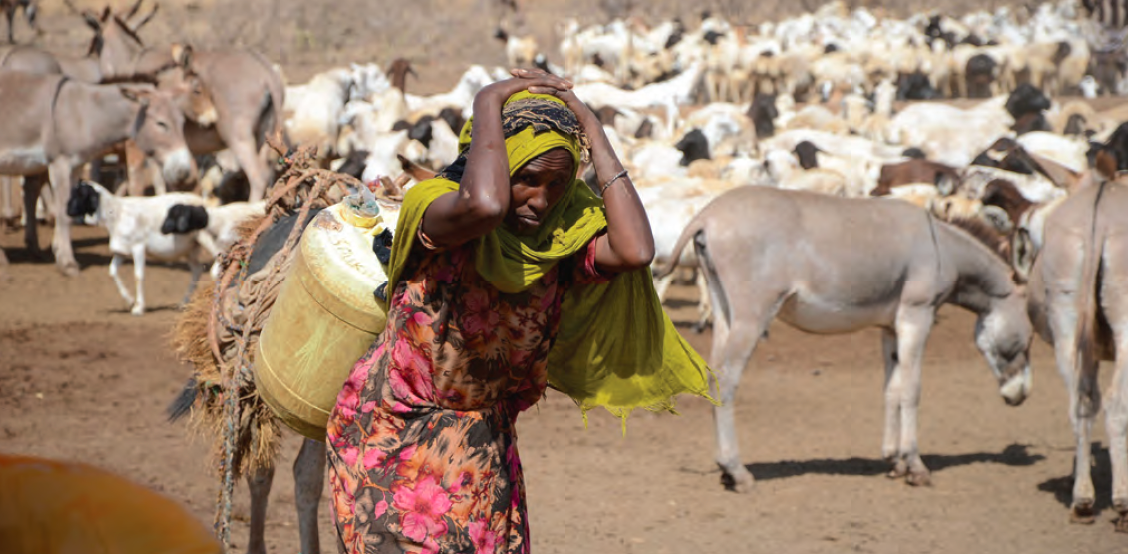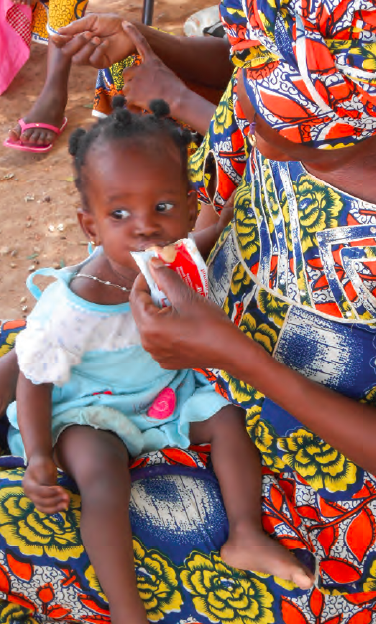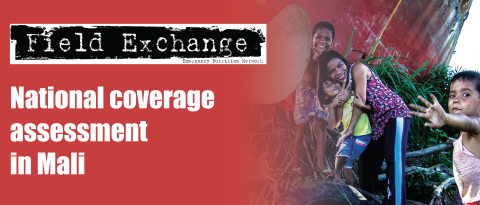Editorial
 Dear readers,
Dear readers,
Following ENN’s bumper issue of Field Exchange on the response to the Syria crisis (issue 48) this issue has reverted to our more normal non-thematic format covering a range of programme types and research areas. We have nine field articles. Three of these relate to CMAM programming. An article by Sarah Morgan, Robert Bulten and Dr Hector Jalipa (World Vision) describes a CMAM programme being implemented in Angola in a context of low staffing capacity and weak health infrastructure that used a volunteer work force yet achieved high cure and coverage rates. Challenges included provision of medical treatment, maintaining effective Ministry of Health RUTF1 supplies and maintaining incentives of staff. A similarly difficult CMAM context in the Democratic Republic of the Congo is described in an article by Ivan Molton and colleagues where a small scale community based and managed RUTF programme was implemented. In order to get buy-in and community ownership, non-standard entrance and targeting criteria were used (children up to 13 years of age were admitted). In practice, just under half of admitted under 5’s and one quarter of over 5’s actually met admission anthropometric criteria for severe acute malnutrition (SAM). The many challenges described in the article appear to have been outweighed by the success, with moderate weight gain recorded for over two-thirds of those admitted, using locally sourced foods to make the RUTF and with the most minimal of external support. A final article on CMAM describes a method and piloting of a new single coverage estimate for performance, which the authors assert can be used in preference to the usual point or period coverage estimates. This can be particularly useful for contexts like multi-district surveys where contextual information is not sufficiently available to make a decision about whether to use point or period coverage.
There are also three field articles about nutrition assessment methods. Two relate to the development and application by Action Contre la Faim (ACF) of their ‘Link Nutrition Causal Analysis (NCA)’ approach, which identifies plausible causes of undernutrition to inform context specific programming. The method involves local stakeholders and multi-sector representatives who help identify seasonal, structural and societal factors contributing to undernutrition. Experiences of its application in Bangladesh and Kenya are described. In Isiolo, Kenya, the community identified the increased workload of women, as a consequence of the drought, as a critical factor and suggested a number of potential solutions. A final article on assessment describes the method and application of a rapid tool for determining the nutrition and other needs of older people (RAM-OP) in humanitarian contexts. The pilot is conducted in an urban and peri-urban setting in Ethiopia. The results are then compared with a SMART survey and found to be comparable but at two thirds of the cost. Further field trials are envisaged.
 There are two field articles that describe ‘nutrition sensitive’ programming. One is about an FAO nutrition sensitive agricultural project in Nepal, which aims to enhance crop and livestock production, increase food diversity, household self-sufficiency and nutrition knowledge and awareness. However, although there was significant impact on crop and livestock production, nutrition and food consumption impacts were not measured. The second is a multi-sector homestead food production programme in Burkina Faso implemented by Helen Keller International (HKI). The authors examine how agricultural and nutrition activities are harmonised and find that this is done in a very ad hoc way. This leads them to come up with a typology of ‘modes of integration’, which they hope will help address explicitly ways of working across sectors. This is particularly topical as efforts to implement and scale up nutrition sensitive programming are increasing in many countries (through initiatives such as the Scaling Up Nutrition (SUN) movement) without clear operational frameworks for how sectors can effectively work together and towards a common aim of improving nutrition. Similarly, the shared vision and commitments of the recent ICN2 meeting (outlined in a views article by ACF) will need clear multi-sectoral strategies and work plans to translate into effective programming. The final field article, written by ACF, describes what is fashionably called ‘resilience’ programming in the arid and semi-arid lands (ASAL) area of Kenya. This is a drought preparedness project for pastoralists via rangeland and pasture regeneration, water harvesting and livestock marketing initiatives. Although implemented in the context of an emergency, the aim of the intervention is to develop longer term capacities with cash transfers providing an excellent mechanism for achieving some of this aim.
There are two field articles that describe ‘nutrition sensitive’ programming. One is about an FAO nutrition sensitive agricultural project in Nepal, which aims to enhance crop and livestock production, increase food diversity, household self-sufficiency and nutrition knowledge and awareness. However, although there was significant impact on crop and livestock production, nutrition and food consumption impacts were not measured. The second is a multi-sector homestead food production programme in Burkina Faso implemented by Helen Keller International (HKI). The authors examine how agricultural and nutrition activities are harmonised and find that this is done in a very ad hoc way. This leads them to come up with a typology of ‘modes of integration’, which they hope will help address explicitly ways of working across sectors. This is particularly topical as efforts to implement and scale up nutrition sensitive programming are increasing in many countries (through initiatives such as the Scaling Up Nutrition (SUN) movement) without clear operational frameworks for how sectors can effectively work together and towards a common aim of improving nutrition. Similarly, the shared vision and commitments of the recent ICN2 meeting (outlined in a views article by ACF) will need clear multi-sectoral strategies and work plans to translate into effective programming. The final field article, written by ACF, describes what is fashionably called ‘resilience’ programming in the arid and semi-arid lands (ASAL) area of Kenya. This is a drought preparedness project for pastoralists via rangeland and pasture regeneration, water harvesting and livestock marketing initiatives. Although implemented in the context of an emergency, the aim of the intervention is to develop longer term capacities with cash transfers providing an excellent mechanism for achieving some of this aim.
There is also a wide variety of research summaries in this issue; notable pieces as follows. A secondary analysis of 21 DHS data sets applying different data cleaning criteria showed a profound effect on reported prevalence of global acute malnutrition (GAM) (most pronounced for SAM) leading to recommendations for mandatory reporting of cleaning criteria, urgent international consensus on optimal cleaning, and real time validation of extreme variables using electronic data collection. A review of the effectiveness of sixmonthly vitamin A distribution, which has been the primary intervention for vitamin A deficiency since the mid-1990s, concludes that this strategy no longer has a marked impact on mortality due to changes in disease patterns. The authors make a strong case for a policy shift from high dose to frequent low dose vitamin A supplementation . Another review found that the bioconversion of Vitamin A (beta carotene to retinol) in pro-vitamin biofortified crops was more efficient than for non-biofortified crops. The authors argue that this supports the focus on efforts to breed plants with increased micronutrient concentrations, to decrease the influence of inhibitors and to offset losses from processing.
An interesting summary of an article on a randomised controlled trial (RCT) in Columbia of an integrated early child development (IECD) intervention for 12-24 month old children found significant effects of stimulation on cognition and receptive language but no significant effect of micronutrient supplementation. We also feature a piece on the high fat, low lean body mass of South Asians and how this is associated with elevated risk of chronic diseases. The review concludes that this is probably due to developmental programming in early life, coupled with nutrition factors and lack of exercise through childhood and adolescence. The authors conclude that food diversification and inclusion of animal source foods would help reduce childhood undernutrition and increase adult lean body mass. Furthermore, childhood undernutrition and adult over-nutrition are a continuum and a larger body of evidence is needed to inform policy on how to deal with this double burden. A related article considers that, in general, the national policy space for public health nutrition is not sufficiently protected. Processed ‘fast’ foods dominate foreign direct investment (FDI) interest in the food sector, yet reduced use of these foods is needed to tackle a number of non-communicable diseases (NCDs). FDI has economic advantages but at the same time, gives a company greater power over the food supply and vested interests in limiting regulation. Legal protection for investors is common, limiting government’s regulatory powers over such companies. Additional research on balancing state interests and legal approaches is needed.
 Also of note is, a review by Tufts University on nutrition responses in emergencies very much accords with current ENN thinking. The authors assert that the contribution of emergency response programming to nutrition goals is rarely considered in assessment of global nutrition agendas, target setting or budgeting. It makes the point that high coverage of effective treatment programmes for wasting in crisis affected countries is needed to reduce child mortality, while global targets for stunting require attention in humanitarian hot spots. In effect, emergency interventions should dovetail with longer-term programming.
Also of note is, a review by Tufts University on nutrition responses in emergencies very much accords with current ENN thinking. The authors assert that the contribution of emergency response programming to nutrition goals is rarely considered in assessment of global nutrition agendas, target setting or budgeting. It makes the point that high coverage of effective treatment programmes for wasting in crisis affected countries is needed to reduce child mortality, while global targets for stunting require attention in humanitarian hot spots. In effect, emergency interventions should dovetail with longer-term programming.
One final article to mention is a news item on the recent Global Nutrition Report (GNR), which is the first in an annual series. It tracks worldwide progress in improving nutrition status, identifies bottlenecks to change, highlights opportunities for action, and contributes to strengthened nutrition accountability. Although progress is being made in meeting some of the World Health Assembly targets, there is - as expected - a long way to go.
Finally, we would like to highlight that the ENN are planning another special issue of Field Exchange – this time on ‘nutrition sensitive’ programming. We will have a guest editorial team to help appraise and guide content. If you are involved in such programming or know someone who is, now would be a good time to start thinking about material to submit (send your suggestions to the contacts below).
We thank our many contributors for providing another rich issue of Field Exchange and hope you enjoy reading issue 49. The next one takes us to a half century. That has to be some kind of landmark!
Yours
Jeremy Shoham & Marie McGrath
Co-editors
Send article ideas for future editions of Field Exchange, including the special issue on nutrition-sensitive programming, to Marie McGrath, marie@ennonline.net
1Ready to Use Therapeutic food


